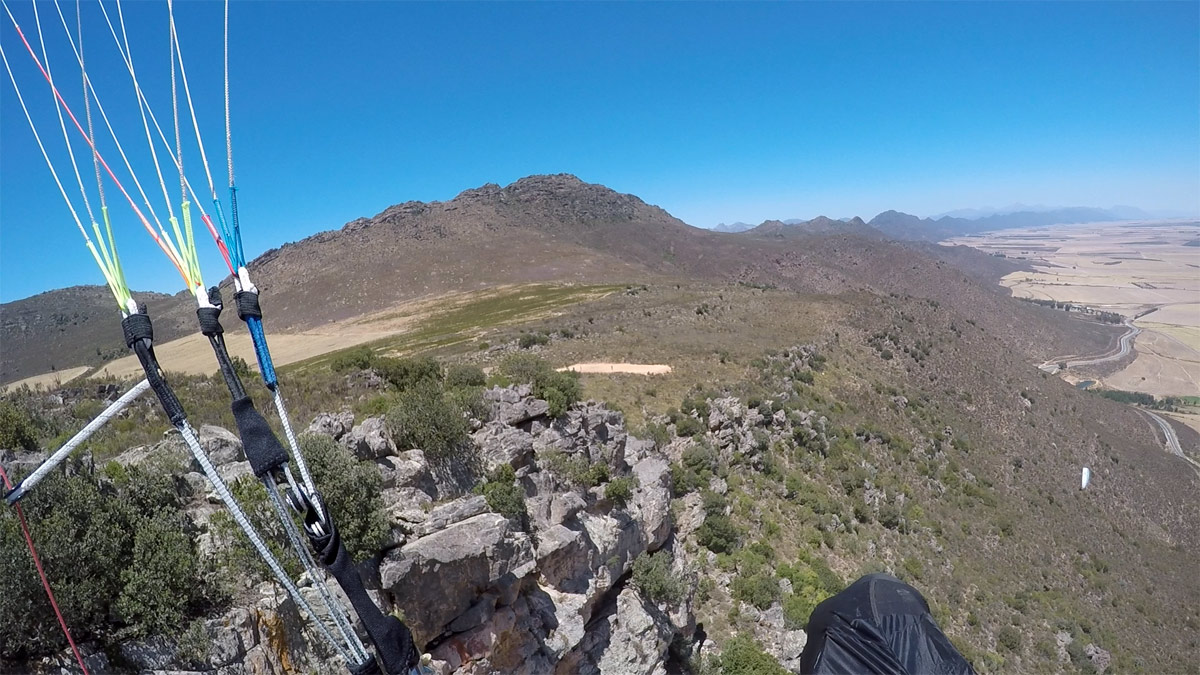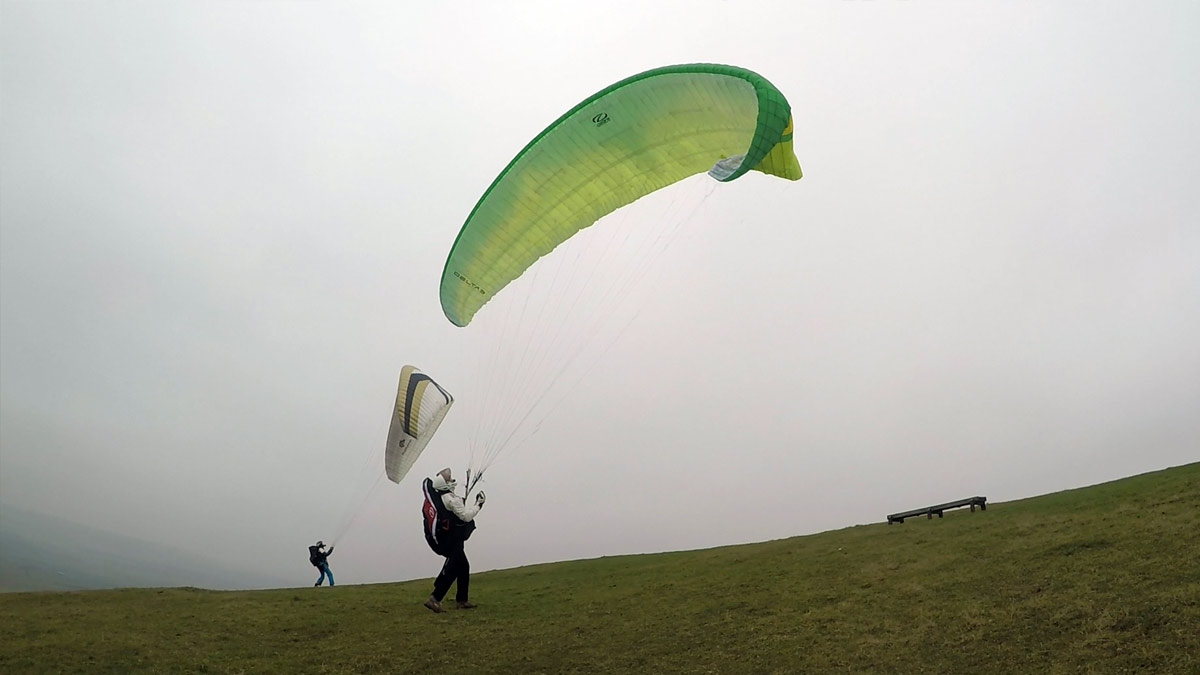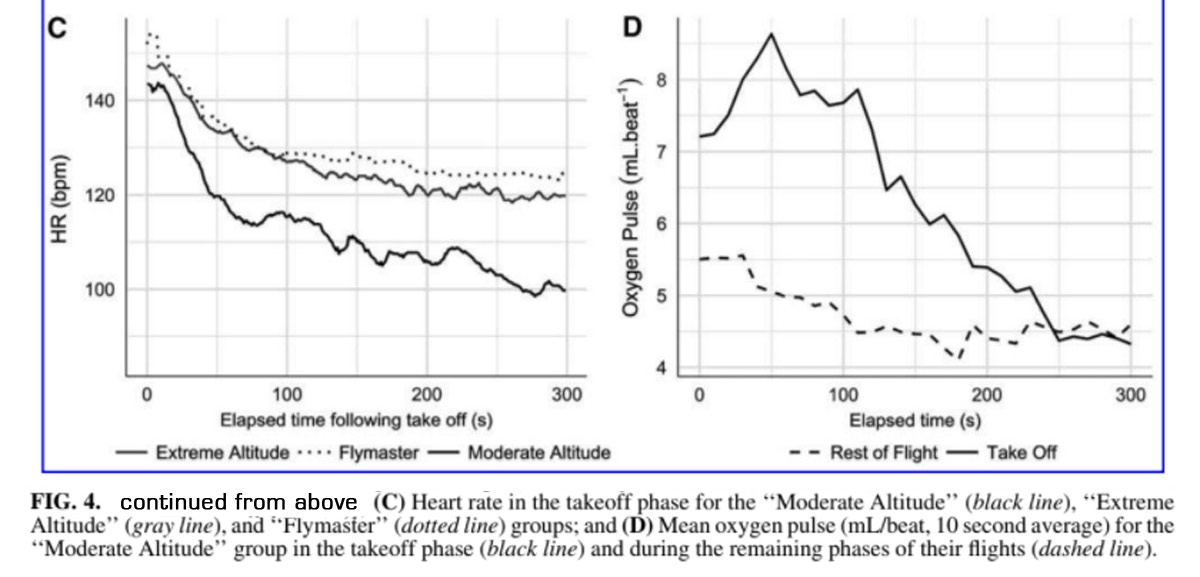
Expedition doctor and paraglider pilot Dr Matt Wilkes and physiological ecologist Dr Lucy Hawkes recently led a research group investigating the effects of altitude on paraglider pilots, under the banner of the Free Flight Physiology Project. The participants included a group of six experienced pilots flying at moderate altitude, two pilots at extreme altitude (high peaks in Pakistan) and data from seventeen pilots of mixed experience flying ordinary sites.

Figure from Wilkes M, MacInnis MJ, Hawkes LA, Massey H, Eglin C, Tipton MJ. The Physiology of Paragliding Flight at Moderate and Extreme Altitudes. High Alt Med Biol. 2017 Dec 21. doi: 10.1089/ham.2017.0127.
Although the high altitude research has produced many useful results, what I’ve chosen to focus on is the discovery that relates to every freeflight pilot. All pilot groups followed a similar pattern across flight phases: takeoff showed a noticeably elevated heart rate. Studies of novice and expert parachutists have demonstrated similar increases in heart rate, as well as cortisol levels, in anticipation of jumping. At around 140 beats per minute, it’s way above an average baseline (resting rate) of 75.
One of the reasons, as Matt suggests, is that takeoff may be a source of anxiety for beginners, and experienced pilots may feel a social pressure to succeed: fellow pilots are watching and there is a keen incentive not to waste time by failing to launch cleanly.

The most important factor is that launch sites typically expose you to the worst risks of the whole flight.
Launches are usually from a mountain, so the launch might be intimidating and steeply sloped, there is uneven steep turbulence-inducing terrain nearby (likely to be uncultivated, with trees or rocks) and the thermal currents are possibly strong. The terrain might cause the true wind direction and strength to be hidden, and if you misjudge these you could be pushed back in a really bad place.
Landings, on the other hand, are often chosen from up high, so you can move your aircraft to a suitable area, typically a wide open flat field, away from turbulence-inducing obstacles. The wind is typically limited at ground level, and even if it isn’t, the wind direction is easy to establish. It is altogether less risky.

On launch, you also don’t know what conditions are like until you are flying. Only once you’ve established the nature of the air on the day you can be reasonably certain everything will be OK. Even in stressful landing situations, you come to them with a current understanding of the conditions, only the terrain is new and requires consideration. On takeoff you have only guesswork to go on: a weather forecast, perhaps some local experience, and those visual clues you can see, limited to waving vegetation, birds and the movement of the clouds. If there are no pilots to indicate the conditions, and you’re the first to go, it can be stressful, no matter your experience level.

If there are pilots airborne already, they will often cluster near the launch site, creating potentially dangerous traffic, probably the most significant risk you will face as a paraglider pilot. Avoiding other wings in such close proximity can be a complex mental challenge.
Pilots with more experience typically fly wings of lower stability in the search for more performance. They require faster reactions and more precise input to keep flying, especially in extremes of turbulence. Their flying speed is higher, and they are harder to launch with complete control. This adds to the stress on launch, so I’d expect an experienced pilot to face similar levels of anxiety to an inexperienced pilot. Only those at an extremely high level of proficiency or those who have chosen to take a step down in performance can enjoy a reduced stress level on launch.
The launch site presents another problem: a lack of familiarity with the feeling of the wing which refreshes the muscle memory required to make instinctive inputs. In many cases, pilots arrive on a takeoff site, there’s no time to waste because it's flyable, they clip in, do their checks, and launch. There’s no time for practice.

This highlights the importance of ground handling sessions, as well as a bit of ‘messing around with the wing’ prior to launching, if the launch site provides such an opportunity.
Wilkes continues, drawing on comparative research: “The physiological responses (elevated heartrate) do not appear to habituate with experience and even though experts may report less anxiety than novices, the physiological responses to parachuting do not appear to change. It has also been noted that high levels of sympathetic activation can impair working memory and safety performance in parachutists.”
His advice: “Given that a high proportion of paragliding accidents occur during takeoff, even experienced paraglider pilots may benefit from relaxation exercises before launch and preflight checklists to mitigate potential deficits in working memory.”
This is a great suggestion. Here’s what we recommend as your absolute minimum preflight checks.
As for relaxation exercises, you might think it would make sense to socialize a bit, chat to your friends on the slope, chill out. I think you’d be better off on your own, doing some ground handling.
There’s a type of pilot you’ll find on launch sites around the world, those who are afraid of flying (probably for some valid reason, let’s face it, it’s a risky sport) and so they talk everyone else out of the sky. They will point out all the dangers, and invent some of their own. They’re often very chatty, because they need to be heard. They will just add to your stress levels. You need to guard against them. Seek out the most experienced pilot for a word of advice and a site briefing, then get to your kit and set about doing a daily equipment inspection, your pre-flight checks ... and the most important bit.
Relax

Relax? You’re just about to jump off into the unknown! The wind is strong. The rocks are everywhere. It’s freakin scary.
- Take five slow deep breaths, and focus only on the air coming into your lungs, and going out. With practice, you’ll find you can make the world go quiet.
- Relax your muscles, unclench your hands, and calmly watch the wind. Try to become one with it. Yes, I know, you can’t see it. Imagine you are flowing over the landscape, and you’re made of nothing more than air.
- Now visualize the first 60 seconds of your flight. A small flight plan, if you will. In your mind’s eye, see yourself judging the right moment, pulling up the wing cleanly, running off with a balanced and stable aircraft, settling into your harness smoothly, banking towards the most likely source of lift, and flying there with active control. Hooking into the thermal, you make a perfect rising turn and climb up to heaven.
Now you’re ready. Follow your script and enjoy the flight. Who cares if it turns out exactly the way you predicted? What you’ve done is to reduce your heart rate in the critical minute. Your confidence will calm you.

What struck me most from the graphs is where all the stress is concentrated: in the first minute. There are valid reasons for having an elevated heart rate. Dangers aside, if it didn’t make you impossibly excited you wouldn’t be doing it, right? You’re about to fly! But now that you know what’s going on inside, you can take a minute to prepare: the essential sixty seconds.
Further information
The study summary is available here. If you would like a copy of the full paper, please get in touch with Matt at the address below.
Matt’s next studies will take place at the Extreme Environment Laboratory in Portsmouth from 26 Feb to 16 March 2018. Interested in volunteering? It will take about half a day, and involve a simulated flight to 4,500 m. Please contact [email protected].
Visit the project website and please like The Free Flight Physiology Project on Facebook

Want to see more? There's no better way to support our efforts than buying from us. We'll ensure you get great service! Choose from our huge range AND enable us to produce more videos and articles to benefit the freeflight community.


